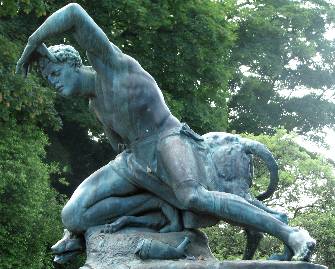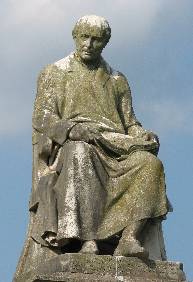Edward Bowring Stephens (1815-1882)
The Deer Stalker.
The sculptor E. B. Stephens, rather obscure for one of those chosen to embellish Burlington House with statues, was born in Exeter in 1815. He studied under E. H. Baily, before attending the RA Schools from 1836. He exhibited at the Academy from 1838 for some 45 years, right through until his death, his final exhibit being shown posthumously in 1883. From 1839 he spent three years in Italy, returning first to London, and then to London. His successes included an Academy gold medal for The Battle of the Centaurs and the Lapithae, a work in relief, in 1843, a statue of Alfred the Great propounding his code of Laws shown at Westminster Hall in the following year, and later, two works shown at the 1851 Great Exhibition: Satan tempting Eve and Satan vanquished. Stephens also made some domestic subjects, such as Maternal Love, Mother and Child and so forth, in a somewhat softened and sentimentalised Greek idiom. I have no knowledge of where these ideal works are now.
The bulk of Stephens's work however, and certainly that which is accessible today, was portrait sculpture. This may be characterised as rather serious, often with a dignified, Roman look, and with a tendency to make the contemporary clothing as Roman as possible. Most of his work was in stone, and not translated to bronze, and in truth some of his bronze examples are less than happy, albeit his stone ones have suffered from the weather. He had something of a leaning towards giving the heads of his full figure subjects a certain largeness, at the upper bounds of proportionality to the bodies.
As an Exeter man, Stephens was much patronised by the great and the good of Devonshire, and fittingly, it is in Exeter where we can see the best collection of his works. In the Royal Albert Museum is his standing stone figure of Albert, and also a portrait bust of the donor of the museum site, Richard Somers Gard.
John Dinham in Northernhay Gardens.
In Northernhay Gardens in the same town are three portrait statues. Two are in stone: Thomas Dyke Acland (1861) and John Dinham (1865). Also now in Northernhay Gardens, though I did not see it, and previously in Bedford Street, is his bronze statue of the 11th Earl of Devon, William Courtenay (1880/1881), described as follows:
"The statue is executed in bronze... the earl stands upright with a roll of paper in his raised left hand, and the artist has been happy in catching a characteristic pose of his model. But not so happy is his representation in a hard medium like bronze, of the folds of a frock coat fluttering in the breeze - perhaps a sculptor's device to break the hard line of an artistically impossible garment. We might cite this as an instance of that modern realism which transgresses the legitimate limits of stone and clay."
A further work by Stephens in Northernhay Gardens, again in bronze, is an important ideal figure, The Deer Stalker (1878), a dramatically crouched semidraped male of athletic proportions, accompanied by his hound.
In London, Stephens has no less than three figures among those on the courtyard facade of Burlington House, home of the Royal Academy. These are Da Vinci, Wren and Reynolds, of which the last named is the best. In Oxford, in the University Museum, one of the several figures against the pillars on the ground floor is by Stephens - Priestley, looking rather too thin of body for the neck and head. And in Brighton is a standing figure of John C Burrows (1878), Mayor, as good an example as any of Stephens's work.
Stephens' statue of Da Vinci, Burlington House.


